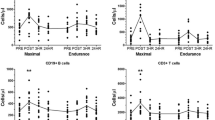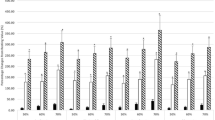Abstract
To study the effects of exercise on natural killer (NK) cell number and activity (NKCA) healthy male (n = 32) and female (n = 32) subjects were randomly assigned to an exercise or control condition. Exercise involved a continuous incremental protocol consisting of cycling for three periods of 6 min at work rates corresponding to 55%, 70% and 85% peak oxygen uptake (\(\dot V{\text{O}}_{2{\text{peak}}}\)). Blood samples were drawn at baseline, at 6 min, 12 min and 18 min during exercise, and at 2 h following completion of exercise. Relative to both baseline and control conditions, exercise resulted in an increase in the number of circulating lymphocytes. The proportion of T cells (CD3+) and B cells (CD19 +) significantly decreased, and NK cells (CD3−CD16+CD56+) increased throughout exercise. NKCA increased (P < 0.001) during the initial 6 min of exercise with no further changes observed, despite increases (P < 0.001) in the number and proportion of circulating NK cells during exercise at 70% and 85% \(\dot V{\text{O}}_{2{\text{peak}}}\). Plasma epinephrine and norepinephrine increased (P < 0.001) above baseline at 12 min and 18 min. The changes in NK cell number and function were independent of gender. The results indicate that short-duration low-intensity exercise can significantly increase NK cell number and activity. However, alterations in NK cell number are not accompanied by changes of a similar magnitude in NKCA.
Similar content being viewed by others
References
Ahmed SA, Penhale WJ, TALAL N (1985) Sex hormones, immune responses, and autoimmune diseases. Am J Pathol 121:531–551
Benschop RJ, Oostveen FG, Heijnen CJ, Ballieux RE (1993) β2-Adrenergic stimulation causes detachment of natural killer cells from cultured endothelium. Eur J Immunol 23:3243–3247
Benzcur M, Matsushima K, Oppenheim JJ, Herberman RB, Ortaldo JR (1984) Stimulatory role of purified IL-1 on human NK cells (abstract). J Leukocyte Biol 36:396
Berne RM, Levy MN (1993) Physiology. Mosby Year Book, St. Louis, Mo. pp 818
Bjune G (1979) In vitro lymphocyte responses to PHA show covariaton with the menstrual cycle. Scand J Immunol 10:362
Brahmi Z, Thomas JE, Park M, Doddeswell IR (1985) The effects of acute exercise on natural killer-cell activity of trained and sedentary human subjects. J Clin Immunol 5:321–328
Christensen LB (1991) Experimental methodology, 5th edn. Allyn and Bacon, Needhan Heights, Mass
Dill DB, Costill DL (1974) Calculation of percentage changes in volumes of blood, plasma and red cells in dehydration. J Appl Physiol 37:247–248
Fletcher MA, Baron GC, Ashman MR, Fischl MA, Klimas NG (1987) Use of whole blood methods in assessment of immune parameters in immunodeficiency states. Diagn Clin Immunol 5:68–91
Foster NK, Martyn JB, Rango RE, Hogg JC, Pardy RL (1986) Leukocytosis of exercise: role of cardiac output and catecholamines. J Appl Physiol 61:2218–2223
Gannon GA, Shek PN, Shephard RJ (1995) Natural killer cells: modulation by intensity and duration of exercise. EXERC Immunol Rev 1:26–48
Hedfors E, Holm G, Ohnell B (1976) Variations of blood lymphocytes during work studied by cell surface markers, DNA synthesis and cytotoxicity. Clin Exp Immunol 24:328–335
Hellstrand K, Hermodsson S, Strannegard O (1985) Evidence for a β-adrenoreceptor-mediated regulation of human natural killer cells. J Immunol 134:4095–4099
Henney CS, Kuribayashi K, Kern DE, Gillis S (1981) Interleukin-2 augments natural killer cell activity. Nature 291:335–338
Hoffman-Goetz L, MacNeill B (1992) Exercise, natural immunity, and cancer: causation, correlation, or conundrum. In: Watson RR, Eisinger M (eds) Exercise and disease. CRC Press, Boca Raton, Fla., pp 37–62
Hoffman-Goetz L, Pedersen BK (1994) Exercise and the immune system: a model of the stress response. Immunol Today 15:382–387
Kappel M, Tvede N, Galbo H (1991) Evidence that the effects of physical exercise on NK cell activity is mediated by epinephrine. J Appl Physiol 70:2530–2534
Kendall A, Hoffman-Goetz L, Houston M, MacNeill B, Arumugam Y (1990) Exercise and blood lymphocytes subset responses: intensity, duration and subject fitness effects. J Appl Physiol 69:251–260
Loucks AB, Mortola JF, Girton L, Yen SSC (1984) Alterations in the hypothalamic-pituitary-ovarian and the hypothalamic-pituitary-adrenal axis in athletic women. J Clin Endocrinol Metab 68:402–411
Lynch EA, Dinarello CA, Cannon JG (1994) Gender differences in IL-1 α, IL-1 β, and IL-1 receptor antagonist secretion from mononuclear cells and urinary excretion. J Immunol 153:300–306
Mathur S, Mathur RS, Goust JM, Williamson HO, Fudenberg HH (1979) Cyclic variations in white cell populations in the human menstrual cycle: correlations with progesterone and estradiol. Clin Immunol Immunopathol 13:246–253
Michaels RH, Rogers KD (1971) A sex difference in immune responsiveness. Pediatrics 47:120–123
Naliboff BD, Benton D, Solomon GF, Morley JE, Fahey JL, Bloom ET, Makinodon T, Gilmore SL (1991) Immunological changes in young and old adults during brief laboratory stress. Psychosom Med 53:121–132
Nieman DC, Miller AR, Hensen DA, Warren BJ, Gusewitch G, Johnson RL, Davis JM, Butterworth DE, Nehlsen-Cannarella SL (1993) Effects of high-versus moderate-intensity exercise on natural killer cell activity. Med Sci Sports Exerc 25:1126–1134
Pedersen BK, Tvede N, Klarlund FK (1990) Indomethacin in vitro and in vivo abolishes post-exercise suppression of natural killer cell activity in peripheral blood. Int J Sports Med 11:127–131
Rabin BS, Kusnecov A, Shurin M, Zhou D, Rasnick S (1994) Mechanistic aspects of stressor-induced immune alterations. In: Glaser, R, Kiecolt-Glaser, J (eds) Handbook of stress and immunity. Academic Press, New York, pp 23–51
Rhodes K, Scott A, Markhan RL, Monk-Jones ME (1969) Immunological sex differences. Ann Rheum Dis 28:104–119
Schuurs A, Verheul H (1990) Effects of gender and sex steroids on the immune response. J Steroid Biochem 35:157–172
Shinkai S, Shore S, Shek PN, Shephard RJ (1992) Acute exercise and immune function. Int J Sports Med 13:452–461
Smith JA (1995) Guidelines, standards, and perceptives in exercise immunology. Med Sci Sports Exercise 27:497–506
Spencer MJ, Chery JD, Powell KR, Mickey MR, Terasaki PI, Mary SM, Sumaya CV (1977) Antibody responses following rubella immunisation analyzed by HLA and ABO types. Immunogenetics 4:365–372
Surkina ID, Gotovtseva EP (1989) The immune state of female athletes and its correlation with menstrual functions and conditions of sports activities. Sports Train Med Rehabil 1:85–88
Targan S, Britvan L, Dorey F (1981) Activation of human NKCC by moderate exercise: increased frequency of NK cells with enhanced capability of effector-target lytic interactions. Clin Exp Immunol 45:352–361
Tvede N, Kappel M, Halkjaer-Kristensen J, Galbo H, Pedersen BK (1993) The effect of light, moderate and severe bicycle exercise on lymphocyte subsets, natural and lymphokine activated killer cells, lymphocyte proliferative response and interleukin 2 production. Int J Sports Med 14:275–282
Tvede N, Kappel M, Klarlund K, Duhn S, Heilmann C, Halkjaer-Kristensen J, Kjaer M, Galbo H, Pedersen BK (1994) Evidence that the effect of bicycle exercise on blood mononuclear cell proliferative responses and subsets is mediated by epinephrine. Int J Sports Med 15:100–104
Author information
Authors and Affiliations
Rights and permissions
About this article
Cite this article
Moyna, N.M., Acker, G.R., Weber, K.M. et al. Exercise-induced alterations in natural killer cell number and function. Europ. J. Appl. Physiol. 74, 227–233 (1996). https://doi.org/10.1007/BF00377445
Accepted:
Issue Date:
DOI: https://doi.org/10.1007/BF00377445




